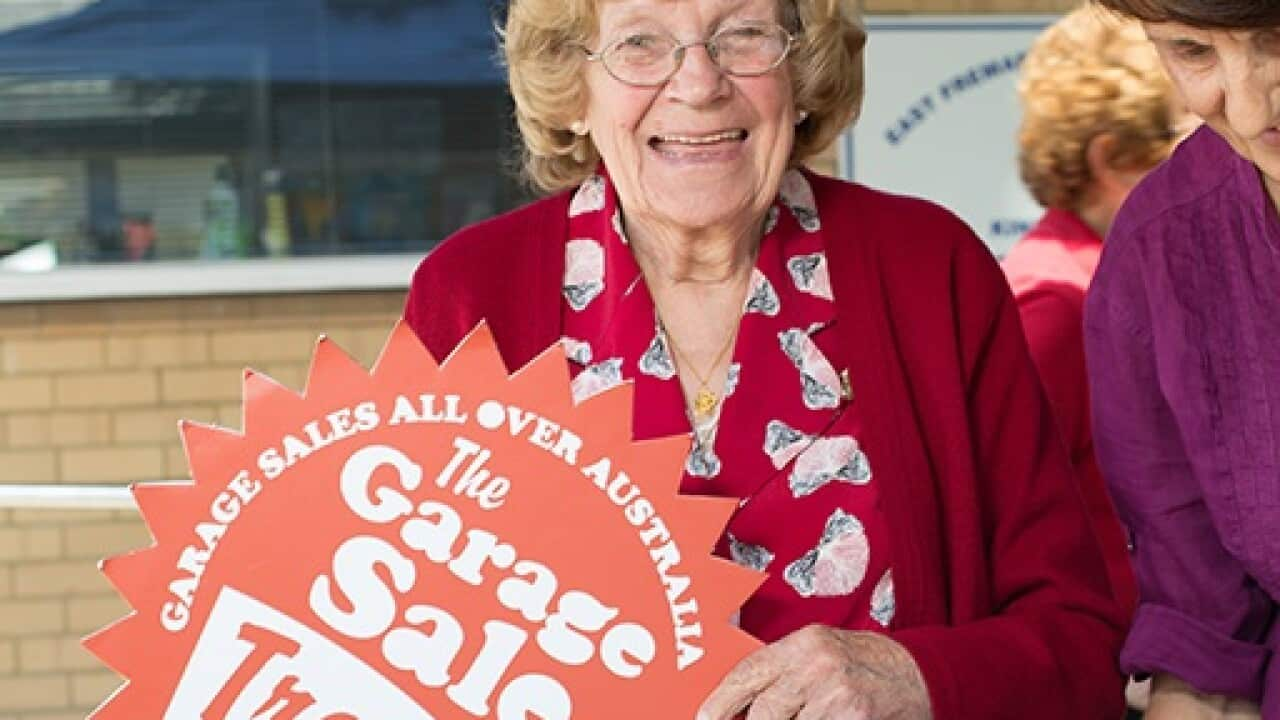Italiano
Victoria Kyriakopoulos, residente a Melbourne, ha accumulato la sua collezione di cimeli di Hello Kitty per 24 anni.
Il costo dell'intera collezione non è di poco conto.
"I've lost count, I think probably well into the thousands, maybe even tens of thousands. I try not to keep track, but probably enough for a house deposit."
Il personaggio immaginario è stato creato nel 1974 dall'azienda giapponese Sanrio.
Sebbene abbia l'aspetto di un gatto, Hello Kitty è una studentessa brillante e di buon cuore, che vive a Londra con la sua famiglia e, secondo la Sanrio, ha anche un fidanzato.
La prima designer, Yuko Shimizu, ha dichiarato di aver inizialmente immaginato il personaggio come una scolaretta, ma di essersi ispirata anche allo Stregatto della favola di Alice nel Paese delle Meraviglie.
Il caratteristico fiocco rosso e l'assenza di bocca sono diventati parte integrante dell'icona, che ha compiuto 50 anni questo 1° novembre.
Nata ad Adelaide, Victoria Kyriakopoulos ha raccontato di aver incontrato Hello Kitty per la prima volta da bambina nelle Filippine, paese di nascita della madre.
Ha detto di essere rimasta immediatamente incantata.
"I was nine years old, it was just before my tenth birthday. I have family in the Philippines, so I was actually heading over for an extended break over my birthday and Christmas, and I was over there and I spotted Hello Kitty. And it was really fascinating to me, because it was something that I hadn’t seen before in Australia. So as a child to see everything cute and pink, and it was really nice."
L'affetto di Victoria per Hello Kitty è cresciuto nel tempo.
"Initially, it was because it was something cute, it was the appeal of not being really able to find it, I think the appeal for me (now) is the fact that even if you have all the money in the world, you’d never be able to go to just one place and buy the whole Hello Kitty collection. You have to go everywhere, and there are different limited edition items. Going out searching for Hello Kitty, having different Hello Kitty experiences around the world - it just keeps it really exciting."
Dall'umile inizio su un portamonete, l'icona globale è apparsa su ogni tipo di merce immaginabile, persino sugli autobus e sui treni ad alta velocità del Giappone.
Il valore netto del marchio è stimato in oltre 120 miliardi di dollari australiani.
Nobuko Burnfield è un'ex animatrice della Sanrio con sede a Sydney.
A suo dire, il successo di Hello Kitty risiede nell'“innocenza e nella semplicità” del design.
(Japanese* then translated into English): "Everyone can think of her as their own cat. She has a way of coming into people’s hearts. It has a borderless appeal. Gender or education level do not matter for Hello Kitty. When Hello Kitty knocks on the door, anyone will gladly let her in."
Naoko Madokoro, ex designer di prodotti Hello Kitty in Giappone, ha spiegato che la capacità di Hello Kitty di adattarsi ed evolversi nel tempo è stata anche un fattore di successo.
(Japanese* then translated into English): "Hello Kitty is adaptable and easily incorporates various trends, which allows her to evolve with the times and align with changing thoughts and perspectives."
Per Madokoro la mancanza di bocca di Hello Kitty permette alle persone di immedesimarsi facilmente in lei.
(Japanese* then translated into English): " When we feel happy, Kitty shares in that joy, and when we're sad, she comforts us. She’s always there, providing a sense of companionship. Kitty is a character that easily allows for emotional connection."
Anche il tempismo potrebbe essere un motivo per cui il marchio ha raggiunto una tale importanza a livello mondiale.
La dottoressa Christine Yano è docente di antropologia presso l'Università delle Hawaii.
Secondo la dottoressa, Hello Kitty è emersa in concomitanza con l'ascesa del fenomeno culturale giapponese chiamato Kawaii o cultura della carineria.
Espressione principale del soft power giapponese, il Kawaii si concentra sulla carineria e sull'innocenza infantile.
Il che ha anche alimentato il consumismo.
"When you think about Japan in the 1970s, it was the birth of girl culture as a kind of consumer item. And that was really where Hello Kitty started, and the development of cute goods. And that was the Hello Kitty world that Sanrio really developed and exploited."
L'autrice di “Globalizzazione rosa: Hello Kitty's Trek across the Pacific”, ha affermato che, pur non potendo individuare un solo fattore alla base del successo, è importante notare il ruolo dell’esecutivo giapponese.
Il governo nipponico ha utilizzato l'iniziativa “Cool Japan” del 2010 come campagna di soft power per promuovere le industrie culturali all'estero, come strumento di crescita economica.
"The Japanese government had part of it, in developing cool Japan. But that’s not the only thing, to a certain extent, they were following the lead of the manufacturers, so it was hand in hand. The fact that Hello Kitty is now fully recognised as a kind of Japan, kind of a cool Japan, I think that’s part of the effect of all of this."
Secondo Victoria Kyriakopoulos, il 50° anniversario è significativo non solo per la longevità del marchio, ma anche per il legame emotivo che i fan hanno con Hello Kitty.
Kyriakopoulos afferma di essere convinta che questo legame durerà per tutta la vita.
"I think the fact that there is a lot of celebration for Hello Kitty is a testament to her popularity. I think the 50th is one of those big milestones. And for me, as a Hello Kitty collector, it’s like one of those once in a lifetime opportunity, so it is really exciting."
Inglese
Melbourne resident Victoria Kyriakopoulos has been building up her collection of Hello Kitty memorabilia over 24 years.
The cost of the entire collection is no small figure.
"I've lost count, I think probably well into the thousands, maybe even tens of thousands. I try not to keep track, but probably enough for a house deposit."
The fictional character was created in 1974 by Japanese company Sanrio.
While she may look like a cat, Hello Kitty is a bright and kind-hearted schoolgirl, who lives in London with her family - and she even has a boyfriend, according to Sanrio.
The original designer, Yuko Shimizu, says she did initially envision the character to be a schoolgirl - but also found inspiration in the Cheshire Cat from the fairytale Alice in Wonderland.
The signature red bow and lack of mouth have become part of the icon, which has turned 50 this year on the 1st of November.
Born in Adelaide, Ms Kyriakopoulos says she first met Hello Kitty as a young girl in her mother’s birth country, the Philippines.
She says she was instantly spellbound.
"I was nine years old, it was just before my tenth birthday. I have family in the Philippines, so I was actually heading over for an extended break over my birthday and Christmas, and I was over there and I spotted Hello Kitty. And it was really fascinating to me, because it was something that I hadn’t seen before in Australia. So as a child to see everything cute and pink, and it was really nice."
She says her affection for Hello Kitty has grown over time.
"Initially, it was because it was something cute, it was the appeal of not being really able to find it, I think the appeal for me (now) is the fact that even if you have all the money in the world, you’d never be able to go to just one place and buy the whole Hello Kitty collection. You have to go everywhere, and there are different limited edition items. Going out searching for Hello Kitty, having different Hello Kitty experiences around the world - it just keeps it really exciting."
From its humble beginning on a coin purse, the global icon has since appeared on every type of merchandise imaginable, even adoring buses and Japan’s bullet trains.
The brand's net worth is estimated to be over 120 billion Australian dollars.
Nobuko Burnfield is a Sydney-based former animator for Sanrio.
She says Hello Kitty's success lies in the "innocence and simplicity" of the design.
(Japanese* then translated into English): "Everyone can think of her as their own cat. She has a way of coming into people’s hearts. It has a borderless appeal. Gender or education level do not matter for Hello Kitty. When Hello Kitty knocks on the door, anyone will gladly let her in."
Naoko Madokoro, a former Hello Kitty product designer in Japan, explains that Hello Kitty's ability to adapt and evolve over time has also been a factor behind the success.
(Japanese* then translated into English): "Hello Kitty is adaptable and easily incorporates various trends, which allows her to evolve with the times and align with changing thoughts and perspectives."
Ms Madokoro says Hello Kitty’s lack of a mouth allows people to easily empathise with her.
(Japanese* then translated into English): " When we feel happy, Kitty shares in that joy, and when we're sad, she comforts us. She’s always there, providing a sense of companionship. Kitty is a character that easily allows for emotional connection."
Timing too could be a reason why the brand has achieved such global prominence.
Dr Christine Yano is a professor of anthropology at the University of Hawaii.
She says Hello Kitty emerged amid the rise of the distinctly Japanese cultural phenomenon called Kawaii or cute culture.
A major expression of Japan’s soft power, Kawaii focuses on cuteness and childlike innocence.
It has also fuelled consumerism.
"When you think about Japan in the 1970s, it was the birth of girl culture as a kind of consumer item. And that was really where Hello Kitty started, and the development of cute goods. And that was the Hello Kitty world that Sanrio really developed and exploited."
The author of 'Pink Globalisation: Hello Kitty's Trek across the Pacific' says while you cannot pinpoint just one factor behind the success, it is important to note the role of the Japanese government.
It used the 2010 'Cool Japan' initiative as a soft power campaign to promote cultural industries to those abroad - as a way of driving economic growth.
"The Japanese government had part of it, in developing cool Japan. But that’s not the only thing, to a certain extent, they were following the lead of the manufacturers, so it was hand in hand. The fact that Hello Kitty is now fully recognised as a kind of Japan, kind of a cool Japan, I think that’s part of the effect of all of this."
She says the 50th anniversary is significant, not just for the longevity of the brand, but also for the emotional connection that fans have with Hello Kitty.
Ms Kyriakopoulos says for her, she believes the connection will be lifelong.
"I think the fact that there is a lot of celebration for Hello Kitty is a testament to her popularity. I think the 50th is one of those big milestones. And for me, as a Hello Kitty collector, it’s like one of those once in a lifetime opportunity, so it is really exciting."










